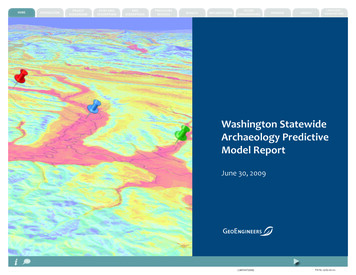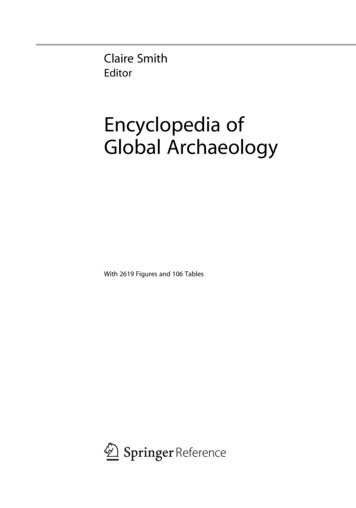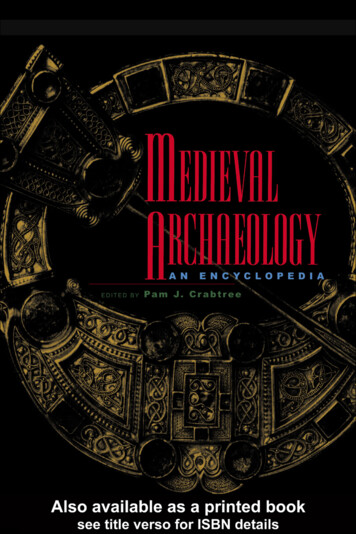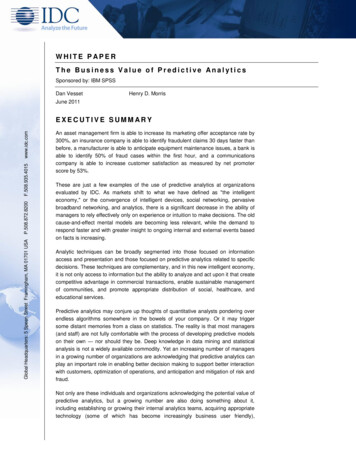
Transcription
HOMEINTRODUCTIONPROJECTBACKGROUNDSTUDY EDITSLIMITATIONS/SIGNATURE PAGEWashington StatewideArchaeology PredictiveModel ReportJune 30, 2009LIMITATIONSFile No. 15265-002-01
HOMEINTRODUCTIONPROJECTBACKGROUNDSTUDY EDITSLIMITATIONS/SIGNATURE PAGEINTRODUCTIONThe Department of Archaeology and Historic Preservation (DAHP)identifies and protects archeological resources in WashingtonState through information and education. Archaeological sites arenonrenewable resources that contribute to our sense of history andplace and define our collective shared heritage. In a sense, we areall responsible for protecting these resources, and the challenge forDAHP is to identify, protect and manage these increasingly threatened archeological resources in a cost-effective and useful manner.The goal of this project is to develop a statewide archaeological predictive model that can help DAHP achieve its overall mission to protect archeological resources.Knowing in advance where archaeological resources might be locatedwill help planners avoid these resources and minimize the regulatoryreview of construction and development projects. Archaeologicalpredictive models can generally help meet these goals by mappingareas with high, moderate, low or unknown potential for containingarchaeological sites based on a series of environmental variables (forexample, distance to water, south-facing slopes). This knowledge canthen be used to avoid or prepare for appropriate mitigation for appropriate locations when planning construction projects. For example,human remains believed to be those of Native Americans were discovered during a septic tank replacement project on Beckett Point, an85-acre development located about 10 miles west of Port Townsend,Washington. The purpose of the 2.8-million project was to replaceaging septic tanks thought to be polluting Puget Sound. Although anexecutive order issued in 2005 requires an archaeological survey forstate-funded projects, the project permits were filed before that order was issued, and so a survey was not conducted before work began. The unexpected archaeological discovery postponed the projectuntil an archaeological survey and evaluation could be completed atthe site. Eventually, this project was allowed to continue, but only after the Public Utility District (PUD) agreed to work with the Jamestown, Port Gamble and Skokomish Tribes and DAHP to ensure thatremains or artifacts discovered would be handled properly. The costsof the additional archaeological work totaled more than 30,000, andthe additional costs for construction delays are yet to be calculated.The Graving Dock project in Port Angeles, Washington, provides another example of the usefulness of knowing where archaeologicalresources might be located. The Graving Dock site was proposed tohouse an on-shore dry dock facility that was to be used to build anchors and pontoons for the new eastern half of the Hood Canal Floating Bridge. This 17-million project was stopped in August 2003 whenconstruction activities exposed cultural resources at the site. The unexpected archaeological discovery postponed the project until theLower Elwha Tribe, Federal Highway Administration (FHWA), U.S.Army Corps of Engineers (USACE), Washington State Departmentof Transportation (WSDOT) and DAHP could negotiate an archaeological treatment agreement for the site. Construction activities weresubsequently delayed for an additional four months while archaeologists collected data from the site, and the total additional cost tothe project was estimated at 7.9 million ( 4.5 million for archaeology and 3.4 million for mitigation). Ultimately, the project was completely halted.Although a predictive modelcannot be guaranteed to predictthe location of a cultural resourcewith 100 percent accuracy, it isa valuable tool to help plannersand archaeologists augmenttheir experience and knowledge,reduce the possibility of surprisesand attempt to avoid costlydelays.The statewide predictive model developed for DAHP identifies bothBeckett Point and Port Angeles Graving Dock as locations with highpotential for discovering archaeological sites. Although a predictivemodel cannot be guaranteed to predict the location of a cultural resource with 100 percent accuracy, it is a valuable tool to help plannersand archaeologists augment their experience and knowledge, reducethe possibility of surprises and attempt to avoid costly delays.For the model to be a useful tool for planning, we developed themodel using standardized and repeatable statistical methods, standard software packages and statewide environmental and cultural resource data. In the current project, locations of known archaeologicalsites are correlated to environmental data to determine the probability that, under a particular set of environmental conditions, anotherWashington Statewide Archaeology Predictive Model ReportPage 2LIMITATIONSFile No. 15265-002-01
HOMEINTRODUCTIONPROJECTBACKGROUNDSTUDY AREADESCRIPTIONSDATADESCRIPTIONSlocation would be expected to contain an archaeological site. In thisway, the model uses environmental conditions to leverage what isknown about existing archaeological sites and to expand that knowledge to unsurveyed or under-surveyed parts of the state. However,we realize that there are reasons for an archaeological site to existeven at a location that may have little or nothing to do with the environmental conditions that we currently have mapped (for example,scenic views, spiritual or religious factors, solar exposure, TraditionalCultural Properties, etc.). Our existing information regarding archaeological sites shows that not all sites occur at locations with highenvironmental probability. For this reason, we added a componentto the model that incorporates spatial proximity into the predictedvalues. This is accomplished by evaluating locations within the studyarea for spatial proximity to archaeological resources and then adjusting the environmental prediction at that location accordingly (seethe “Processing Methods” section for more details regarding thesemethods). Using this method, the model combines the environmental information with the local information developed by field surveysfrom archaeologists to identify locations across the state with a rangeof high, moderate, low and unknown probabilities for discovering anarchaeological site. The model information will be available via theDAHP web portal (WISAARD) to qualified personnel and agencies foruse in project review, planning and protection of these valuable, nonrenewable TURE PAGEReferences“A field guide to Washington State Archaeology”, 2003, “Electronic files reviewed May 2009. /FieldGuidetoWAArch 000.pdfWashington State Department of Transportation, “Port Angeles GravingDock Project Readies for Re-start”, March 16, 2004. Electronic files reviewedMay 2004. http://wsdot.wa.gov/news/ 2004/mar16 hoodcanalgravingdockupdate.htm.Washington Statewide Archaeology Predictive Model ReportPage 3LIMITATIONSFile No. 15265-002-01
HOMEINTRODUCTIONPROJECTBACKGROUNDSTUDY EDITSLIMITATIONS/SIGNATURE PAGEPROJECT BACKGROUNDArchaeological predictive modeling for Washington State began asa pilot study completed in 2004 involving a sample area in SouthCentral Washington, as shown in Figure 1. This pilot study was a veryimportant first step in determining whether a statewide model wouldbe feasible. In many ways, this study helped to lay the foundationupon which the statewide model is now built. Even at the beginningof this first pilot study, our goal was to eventually develop a statewidemodel. Some of the requirements for the model included the capabilities to: 1) repeat and update the results on a regular basis; 2) expandthe model to use other datasets when or if they become available; 3)run the model using standard software packages; and 4) expand themodel to a statewide model.We worked with archaeologists to identify environmental data thatwould be important in predicting archaeology sites, and then wematched those data elements with the datasets available statewide.It was during this pilot project that we decided on the environmentaldata that would become the building blocks for the statewide model.These include elevation, slope, distance to fresh water, aspect, soils,geology and landforms. Landforms were the only dataset identified asnot being available from another organization, yet vitally importantto archaeological predictive modeling. We tested several methods forlarge-scale landform data development (see the “Data Descriptions”section for details on the methodology we adopted for the statewidemodel). We also identified the need for cultural information to begleaned from the Government Land Office (GLO) maps and began theprocess of georeferencing and digitizing from these maps.As part of this pilot study, we researched other archaeology models.Specifically, we chose two models for more detailed examination,based on their use of environmental factors combined with statisticsand GIS to develop archaeology models for large areas of land: theMinnesota and British Columbia Forest Land Archaeology Models(MnModel and BCModel, respectively). We compared developmentFigure 1. Study Areas for the 2004 (South-Central) and 2006 (Hood Canal) Pilot Studiestechniques when possible because statistics, environmental data andGIS were integral to the development of our model (WAModel). Thecommon theme in these predictive methods is the use of environmental data, which can be made available within a GIS database, to identifythe most likely locations for new archaeological discoveries. The mostobjective approach seemed to be logistical regression analysis, but itsmajor shortcoming is that it treats each grid location as being independent of all other grid locations and assumes a linear relationship between a variable and site location. Ideally, spatial dependence and spatial proximity should play a major role in making spatial predictions. Weinitially tested logistical regression for our pilot study areas; however,the estimation performance of the regression was poor and the modelswere not statistically significant. We tested and adopted the Bayesianstatistical methods as the best way to model archaeological resourcesin Washington.The GIS technology and computer processing speeds have changedsince this initial model was developed. This pilot study was primarilydeveloped using ESRI’s ArcView 3.2 with Microsoft Access databasesWashington Statewide Archaeology Predictive Model ReportPage 4LIMITATIONSFile No. 15265-002-01
HOMEINTRODUCTIONPROJECTBACKGROUNDSTUDY AREADESCRIPTIONSDATADESCRIPTIONSfor some of the processing. The statewide model has been developedusing current technology including ArcGIS 9.3, python and model builder scripting, SQL server and .NET programming (see the “ProcessingMethods” section for additional details).To complement the first pilot study conducted in Eastern Washington,an area in the Western part of Washington in the vicinity of Hood Canal, as shown in Figure 1, was selected for the second pilot study, whichwas completed in 2006. This pilot study indicated that the techniquesoriginally developed for Eastern Washington would work in the different environmental conditions of Western Washington. These tests weresuccessful and confirmed that the Bayesian techniques would be appropriate to use on a statewide model. In this second pilot study, wealso introduced the concept of integrating spatial proximity with theenvironmental data into the predictive capabilities of the model. Because of the volume of information being processed, we generalizedthe spatial proximity calculations to larger areas. Although the endresult was not specifically able to be used for management purposes,the testing did confirm that spatial proximity could be integrated intothe model. We also developed a preliminary “confidence” layer for themodel that could indicate a confidence in the predictions being developed. This was a test case that we have more fully developed forthe statewide effort. Full details of these additions are included in the“Processing Methods” section of this discussion. In summary, we havespent several years developing and refining our methods for an archaeological predictive model. Through two separate pilot studies (SouthCentral 2004 and Hood Canal 2006), we have honed our methods fordeveloping environmental data to be used in the WAModel. Additionally, we have tested and compared several methods for statistically estimating the most likely locations for new archaeological discoveries.Our methods were designed to be as automated as possible to allowthe model to be updated as new data become available. In developingthe WAModel, we used our years of experience and extensive testing tomake the model as consistent and accurate as possible at the SIGNATURE PAGEReferencesCardinali, R., Carla, R., and Carrara, Jacoli M., “GIS Techniques, Remote Sensing and Multivariate Models in Assessing Archaeological Resources,” Electronicfiles reviewed on May 14, 2004. http://deis158.deis.unibo.it/archeo/chapt 1.htmlClement, Christopher Ohm, De, Sahadeb and Kloot, Robin Wilson, “Using GISto Model and Predict Likely Archaeological Sites,” Electronic files reviewed onJuly 2, 2003. sional/papers/pap651/p651.htmMiller, S.M., T.W. Cundy, D.L. Murphy, P.D. Richards, 2001. Using Digital TerrainData and Conditional Probability to Evaluate Landslide Hazard; in Unearth aWorld of Opportunities (Proc. of Conf. 32, IECA), IECA, Steamboat Springs, CO,p. 153-165.Almagro-Gorbea, M., P. Alonso, J.E. Benito, A.M. Martin, J.L. Valencia, 2002.Statistical quality control in archaeological survey. Archaeological Prospection,9(2):45-53.Goings, C.A., 2003. A Predictive Model for Lithic Resources in Iowa. Plains Anthropologist, 48:53.Kvamme, K.L., 1992, A Predictive Site Location Model on the High Plains. PlainsAnthropologist, 37:19-40.Woodman, P.E. and M. Woodward, 2002. The Use and Abuse of StatisticalMethods in Archaeological Site Location .odeling. In Contemporary Themes inArchaeological Computing, D. Wheatley, G. Earl, and S. Poppy eds., p. 22-27.Univ. Southampton Dept. of Archaeo. Monograph No. 3, Oxbow Books, Oxford, England.Minnesota Department of Transportation, “Mn/Model Minnesota Archaeological Predictive Model.” Electronic files reviewed on June 2, 2004. http://www.mnmodel.dot.state.mn.us/Eldridge, Morely and Mackie, Alexander. March 1993. “Predictive Modeling andthe Existing Archaeological Inventory in British Columbia.” Electronic files reviewed June 10, 2004. http://srmwww.gov.bc.ca/risc/o docs/culture/pm/index.htmWashington Statewide Archaeology Predictive Model ReportPage 5LIMITATIONSFile No. 15265-002-01
HOMEINTRODUCTIONPROJECTBACKGROUNDSTUDY EDITSLIMITATIONS/SIGNATURE PAGESTUDY AREASIn order to develop a statewide model, we needed to divide the stateinto smaller areas that could be reasonably processed during the modeling efforts. The study area boundaries were generally based on environmental factors including physiographic provinces, ecoregions andhydrographic boundaries. Physiographic provinces are areas of similar terrain that have been shaped by a common geologic history.1 Anecoregion is an area characterized by a distinct collection of naturalcommunities and species, often heavily influenced by climate. Hydrographic boundaries may include watershed divides or major rivers.Using these parameters to consider overall environmental factors, thestate was divided into specific study areas where pre-contact (that is,prior to any European influence) human land use would likely be consistent. Overall size was also a factor in determining the study areaboundaries. Individual study areas were kept within a size range thatwould be reasonable for computer processing time. Most boundarieswere determined in large part by physiographic provinces, with theedges refined by using ecoregions and watershed boundaries. Countyboundaries were not used to define study areas because administrativeboundaries do not accurately portray pre-contact human land use patterns. This approach resulted in dividing the state of Washington intonine study areas, as shown in Figure 1. Coastal Washington (6,300 square [sq.] miles). This area includesthe Olympic Mountains and the Willapa Hills. The Olympic Mountains form the core of the Olympic Peninsula. The Willapa Hills aredefined by the low-lying coastline and major estuaries (Grays Harbor and Willapa Bay). Puget Lowland (6,200 sq. miles) and Lower Columbia (3,600 sq.miles). The Puget Lowland and Lower Columbia have similar characteristics as low-lying areas generally located between CoastalWashington and the Cascade Range. The Puget Lowland area wascovered by the continental ice sheet during the Quaternary timeperiod. Glacial erosion and deposition established existing water-The study area boundaries weregenerally based on physiographicprovinces, ecoregions andhydrographic boundaries.Figure 1. Study Areas for the Washington Archaeological Predictive Model (WAModel)ways and drainages prevalent in the Puget Lowland. The LowerColumbia study area was delineated using ecoregions and watershed boundaries to create an area of generally consistent fluvialcharacteristics, with consideration to both geomorphic processesand pre-contact human use. North Cascade (12,000 sq. miles) and South Cascade (4,800 sq.miles). North Cascade and South Cascade have similar characteristics and are defined by high topographic relief. The North Cascaderegion has the second largest concentration of alpine glaciers inthe United States. The South Cascade area is home to three activevolcanoes (Mount Rainier, Mount Adams and Mount St. Helens). Upper Columbia (13,600 sq. miles), Yakima Fold/Thrust Belt (8,700 sq.miles) and Spokane (3,900 sq. miles). These areas generally constitute the Washington State portion of the Columbia Basin province,which was subdivided along major rivers and ecoregions to maintain a reasonable size range of each study area for practical computer processing time. These areas are defined by loess hills andWashington Statewide Archaeology Predictive Model ReportPage 6LIMITATIONSFile No. 15265-002-01
HOMEINTRODUCTIONPROJECTBACKGROUNDSTUDY AREADESCRIPTIONSDATADESCRIPTIONSrivers overlying basalt. Repeated late-glacial flooding within thisarea created the Channeled Scablands, which include topographicfeatures such as coulees, buttes, mesas, dry waterfalls, hangingvalleys and giant ripples. ERATIONSAPPENDIXCREDITSLIMITATIONS/SIGNATURE PAGEReferenceLasmanis, Raymond, 1991, The geology of Washington: Rocks and Minerals, v.66, no. 4, p. 262-277.Okanogan Highlands (8,600 sq. miles). This area is defined by itsrounded mountains and deep, narrow valleys. The OkanoganHighlands area is bisected by the Columbia River. This area wascovered by the Okanogan lobe of the Cordilleran ice sheet duringthe Quaternary time period and formed lakes in the Columbia andPend Oreille River Valleys.Washington Statewide Archaeology Predictive Model ReportPage 7LIMITATIONSFile No. 15265-002-01
HOMEINTRODUCTIONPROJECTBACKGROUNDSTUDY EDITSLIMITATIONS/SIGNATURE PAGEEnvironmental Data Cultural ResourcesIntroductionEnvironmental Data - IntroductionThis project correlates information about archaeological sites, archaeological surveys and possible site locations with the environmentaldata to help predict where additional archaeological resources mightbe found within Washington State. For the purposes of this model, wefocused on seven different types of environmental data: Elevation Slope Percent Aspect Distance to Water Geology Soils Landforms Elevation Data Slope Percent Aspect Distance to Water Geology Soils Landformscategorized into 8-18 groups each. Archaeologists, geologists and soilscientists, as appropriate, assisted with identifying the groups so thatthey reflected similarities of the underlying data. For example, geology was grouped based on age of the geological formations as well asgeologic types. See below for additional details for each environmental dataset and their specific groupings.Data Assumptions/LimitationsThe environmental data included in the model were chosen by considering several key criteria—namely, that the data should be: 1) availablein GIS format or available for conversion to GIS format; 2) easily obtainable from public sources; 3) available for the entire state; 4) availableat a reasonable scale or resolution for the model; and 5) identified byarchaeologists as highly influencing the likelihood of the presence ofan archaeological site.The environmental datasets were obtained or derived from the sources (described below) in GIS format. The data were converted to Washington’s standard projection (Washington State Plane South NorthAmerican Datum of 1983 [NAD 83] High Accuracy Reference Network[HARN] feet) and converted to 100-foot grids. The processing methodsfor the overall model uses interval probabilities to correlate the archaeological data with the environmental data. In order to calculate probabilities across a study area, each dataset needed to be grouped so thatthe probabilities would be meaningful when processing the model (see“Processing Methods” section for additional details). Datasets wereArchaeological data utilized in developing the Washington State Archaeological Predictive Model is based on simple principles that arerelevant to archaeological research. The assumptions and key variables which make up the model are influenced, in part, on researchfor other large-scale archaeological predictive models, with notabledifferences. The Washington model is based on a simple premise; prehistoric people in Washington State were hunter/fisher/gatherers whotargeted and utilized key resources through time. Although the resource focus and availability sometimes changed, it’s possible to focuson a finite set of fundamental variables either required or otherwisesought by prehistoric people.Archaeological data utilized indeveloping the Washington StateArchaeological Predictive Model isbased on simple principles that arerelevant to archaeological research.As with most GIS based geoprocessing models, this model is dependent on the limitations of the input environmental data regardingquality and scale in the original data. Limitations of the original dataare applicable to the overall model. Please refer to the original sourcedata for all limitations that may apply.The following assumptions were made regarding the data used in themodel and how they relate to predicting archaeological discoveries.1.Known archaeological sites represent locations of past human activity.2.Human and animal behavior is patterned; hence, the locations(archaeological sites) people used in the past should have relationships to specific environmental variables that range fromWashington Statewide Archaeology Predictive Model ReportPage 8LIMITATIONSFile No. 15265-002-01
HOMEINTRODUCTIONPROJECTBACKGROUNDSTUDY EDITSLIMITATIONS/SIGNATURE PAGEEnvironmental Data Cultural ResourcesIntroduction Elevation Data Slope Percent Aspect Distance to Water Geology Soils Landformssimple to complex. Proximity to these environmental variables,therefore, is knowable.3.Archaeological sites are components of broad cultural systems,and their locations are at least in part dependent on the locationof other system components, such as water sources, raw materialsources and other archaeological sites.4.Archaeological sites are location-dependent. They exist in plannedproximity to activity-specific resources.5.Travel between archaeological sites may determine site locations;geomorphic features of the landscape play a significant role inland-use preference because mobility to and from necessary resources is a significant factor in the decision making process thatleads to their use.6.Ethnographic and archaeological site data demonstrate thatmany settlement and activity locations were reoccupied throughtime.7.Environmental variables are fluid and change over both short- andlong-time frames, fundamentally influencing archaeological sitelocation.Washington Statewide Archaeology Predictive Model ReportPage 9LIMITATIONSFile No. 15265-002-01
HOMEINTRODUCTIONPROJECTBACKGROUNDSTUDY EDITSLIMITATIONS/SIGNATURE PAGEEnvironmental Data Cultural ResourcesIntroductionElevation DataThe clearest intuitive relationship between archaeological sites andrelative elevation may occur at the lowest elevations. Gravity ensuresthat water tends to move downslope. Groundwater recharge occurs atlocations where the water base level meets the ground surface, whereit is then available for use by humans and animals in a stream, river, lakeor wetland. Although relatively few linear relationships exist betweenelevation and archaeological site locations, archaeological sites mayhave a relationship to changes in relative elevation. For example, inmany environments, land at a relatively higher topographic elevationthan the surrounding landscape may promote drainage, may providea better view of the surroundings, and may also increase defensibility.Figure 1: Example of elevation classificationThe elevation data we used for the model were obtained from the United States Geological Survey (USGS). The digital elevation data are aproduct of the USGS’s effort to provide 1:24,000-scale Digital ElevationModel (DEM) data for the continental United States. The USGS National Elevation Dataset (NED) is the result of merging the highest resolution elevation data available across the country into a seamless gridof data known as a “raster.” The NED has a consistent horizontal andvertical spatial reference (NAD 83 and North American Vertical Datum Elevation Data Slope Percent Aspect Distance to Water Geology Soils Landforms1988 [NAVD 88], respectively) and uses a geographic projection witha resolution of one-third arc second (approximately 10 meters) withelevations measured in meters. The NED is a living dataset and is updated by the USGS bimonthly to incorporate the best elevation dataavailable. The DEM for this project was developed from the USGS’sNED obtained in June 2007. Once the NED data were downloaded, wegenerated a resulting DEM for Washington State.The NED data for Washington State were downloaded from USGS in250-megabyte increments referred to as “tiles.” Once DEM data forthe entire state were acquired, the data were mosaicked together tocreate one seamless dataset. Mosaicking is a process where individualraster files are appended together to create one seamless file. In assembling the Washington State DEM, corrections were made duringthe mosaic process to minimize errors in the data, to perform edgematching to prevent seams and to fill small areas of missing data.Seams or discontinuities will occur along tile edges because of differences in the quality and accuracy of the input DEM. These seams werecorrected to provide useful data for this project. Seams also arise whenan offset occurs in the elevation values between two DEMs. An edgematching operation was used to detect offsets along a seam.Archaeological sites may have arelationship to changes in relativeelevation.After the elevation data were mosaicked and refined, the units of measure were converted from meters to feet to provide a common unit ofmeasure among all datasets used for this project. Feet were chosenas the unit of choice in order to preserve the higher precision of otherdatasets already using feet. To make the unit conversion for the elevation data, a projection transformation was required to transform dataoriginally projected in the geographic coordinate system, which useslatitude/longitude as units of measure, to NAD 83 HARN State PlaneSouth (feet), which uses feet. A bilinear interpolation algorithm wasused to perform the horizontal projection transformation, and mapalgebra (the elevation value was multiplied by 3.28) was used in thevertical conversion from meters to feet.Washington Statewide Archaeology Predictive Model ReportPage 10LIMITATIONSFile No. 15265-002-01
HOMEINTRODUCTIONPROJECTBACKGROUNDSTUDY EDITSLIMITATIONS/SIGNATURE PAGEEnvironmental Data Cultural ResourcesIntroduction Elevation Data Slope Percent Aspect Distance to Water Geology Soils LandformsWhen all the data were transformed into a common unit of measure(feet), the dataset was clipped to the boundary of Washington State.This step removed portions of the DEM that overlapped into Oregonand Idaho. The process of clipping the data to the state boundary performed two functions: (1) reducing the file size, and (2) ensuring thatany analysis performed thereafter would focus only on the area withinWashington State.In order to efficiently work with the data, we grouped the elevation values into groups or value ranges. The following table lists the groups forthe elevation dataset.ElevationGr
Washington Statewide Archaeology Predictive Model Report Page 4 LIMITATIONS File No. 15265-002-01 PROJECT BACKGROUND Archaeological predictive modeling for Washington State began as a pilot study completed in 2004 involving a sample area in South-Central Wash










